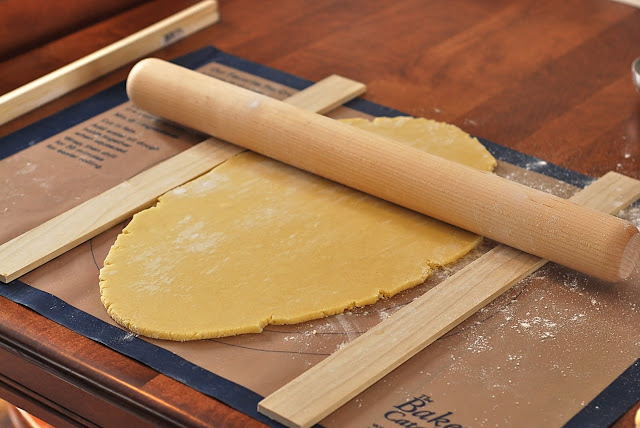
If you're making a lot of cookies, it helps to have a method for keeping them the same thickness, so they look uniform and cook evenly.
There are other tools you can buy for rolling out dough but I'll tell you why they don't work for me:
1. rolling pin rings - I don't like the rolling pin rings because I like to be able to roll up and down as well as diagonally and well, they just get into the way and I end up making ring marks right across the dough. And then I get annoyed!
2. adjustable pastry board - at a whopping $75, it is expensive and would take up valuable space in the kitchen. I think it would be awkward to use and would limit the size of dough you could roll out.
1. Inexpensive Wood Pieces: I went down to my local Home Depot and scoured the place for some wood pieces that were approximately 1/4" thick. They had to be square or rectangular shapes so they wouldn't roll around on the table under my rolling pin. I found a couple of things I thought might work and had the guy at Home Depot cut them for me about 18 inches long. (See both in the first photo.) The thinner, wide pieces are exactly 1/4" or .6 cm thick and those are the ones I use the most. The thicker square dowels are 3/8" or 1 cm thick. I think I spent $5 or less for all the pieces.
2. Silicone Rolling Mat: This is not necessary, but nice to have. As you can see, mine has been well used! It 's a little pricey at $30 from King Arthur Online, but I've also seen similar ones at Bed, Bath, and Beyond and with a coupon you could probably get it for about $20.
The silicone rolling mat is bigger than a cookie sheet Silpat liner and also great for rolling out pie dough. If my dough gets too soft while I'm rolling or cutting, I can slip the whole mat, with the dough on top, onto a cookie sheet and place it in the freezer for a few minutes. Soft, warm dough is difficult to cut-out and transfer to cookie sheets.
3. French Style Rolling Pin - I found this rolling pin while browsing a Sur la Table store on vacation. My kitchen is chock full of gadgets and accessories, so when I start browsing a kitchen store I really need to ask myself, "Do I need it? Do I have a place to put it? Do I already have it?" Most things I see I don't need, don't have a place for, or already have anyway! But when I saw this rolling pin, I grabbed it and ran to the register and never looked back! It is absolutely worth the $17 price tag. I love this rolling pin because it is long enough that I can even roll diagonally a little and doesn't have tapered edges, so it works perfectly for getting evenly rolled out cookies.
1. Chill the dough in the refrigerator for at least an hour. After it has been chilled, dust your work surface with flour, break the dough into tennis ball-sized pieces (I use a metal dough scraper) and then knead them together briefly to get a smooth, but still cold (but not too cold) ball of dough. I find this process makes the dough a lot easier to work with and prevents jagged edges and cracks along the outer edges of the rolled out dough.
2. Sprinkle the mat or counter and the surface of the dough with flour to keep it from sticking.
3. Start rolling to flatten the dough, and once or twice during the rolling process, lift the dough off the surface and throw a little more flour underneath the dough. You can flip the dough as well, which will help prevent any cracks from forming on the underside of the rolled dough. Flour and cold dough are the keys to keep the dough from sticking to things.
4. After the shapes are cut out and placed on the baking sheet, put the entire baking sheet (uncovered is fine) in the freezer for at least 15 minutes. The baking sheet can go right from the freezer into a preheated oven. This freezer time helps the cookies to retain their shape.
5. You can make the dough ahead of time, wrap it in a double layer of plastic wrap and refrigerate for up to two days, of freeze for up to a week. I keep a stack of peel-off address labels and a Sharpie in the kitchen for labeling things that go into the fridge or freezer and I make sure to include the date on the label. If the dough has been frozen, thaw in the refrigerator overnight to thaw.
6. Below: see how this method produces a consistent and even cookie! You can find my sugar cookie recipe here.






Great info!
ReplyDeleteI love making rolled sugar cookies with royal icing...they always look so professional.
This was so helpful...well done.
Janet xox
Thank you so much Miss!!! Now I'm on the hunt for a rolling pin that doesn't have tapered edges...as well as a trip to Home Depot!
ReplyDeleteI had no idea there even was such a thing as an adjustable pastry board! I like the wood pieces idea. Our dough never gets rolled out to a uniform thickness, resulting in thin cripsy cookies and thick cookies and some that are thin on the edges but thick in the middle!
ReplyDeleteAwesome info! Thanks for sharing
ReplyDeleteOh you tricky, tricky Marzipan!
ReplyDeleteWhat a great great post! I love your tips!! I use wooden rulers! I amd jealous of your rolling pin! ♥- Katrina
ReplyDeleteThanks for these helpful tips! Sugar cookies have been my bane-hopefully not anymore!
ReplyDelete